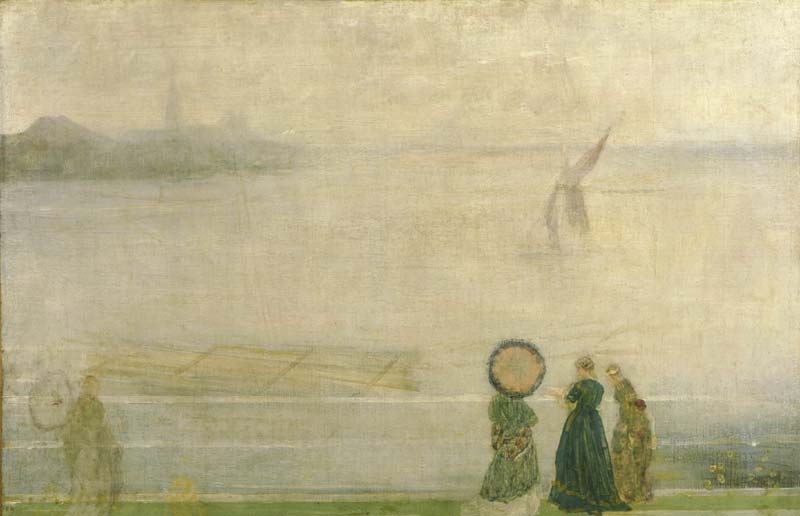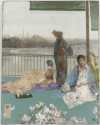Titles
Whistler's original title is not known. The suggested title is as follows:
- 'Battersea Reach from Lindsey Houses' (1960, Arts Council). 1
- 'Battersea Reach from Lindsey Houses' (1980, YMSM). 2
Description
A view across a broad river, in horizontal format. There are women on the near shore, at lower left and right, a sailing boat in mid-stream, to right, and buildings on the far shore, with mist or fog making everything indistinct. One of the three women at right is holding a parasol.
Site
The view is from Whistler's house in what is now Cheyne Walk, Chelsea, London, looking south across the river Thames to the Battersea shore.
This view of Battersea Reach from Chelsea is seen in many of Whistler's paintings of the 1860s and 1870s, including Grey and Silver: Old Battersea Reach [YMSM 046], Chelsea in Ice [YMSM 053], Grey and Silver: Chelsea Wharf [YMSM 054], Variations in Flesh Colour and Green: The Balcony [YMSM 056] (and the Sketch for 'The Balcony' [YMSM 057]) and Study of Draped Figures [YMSM 058]. It is also seen in several Nocturnes, such as Nocturne in Blue and Silver [YMSM 113], Nocturne [YMSM 114], Nocturne: Blue and Silver - Battersea Reach [YMSM 119], and Nocturne: Battersea [YMSM 120].
Comments
Richard Dorment commented on Whistler's blend of realism, japonisme and aestheticism:
'How could he reconcile this quest for decorative perfection with the teeming reality of the dredgers, tugboats and penny steamers he actually saw from his balcony? The answer becomes clear in a picture such as Battersea Reach from Lindsey Houses ... a view looking across the river to a coal slag on the Battersea side. But now, instead of the working class bargemen in the foreground Whistler places fashionably dressed Victorian ladies, two carrying open parasols that make them look like delicate figures on a Japanese screen.Now too, a fog has clothed this banal cityscape in a diaphanous mist. For most Londoners London’s notorious fogs were no more than an unhealthy nuisance created by coal fires and industrial pollution. Whistler was the first artist to see their beauty, and to realise that the blurred outlines of bridges and boats glimpsed through soft grey haze was worthy of aesthetic contemplation.
Whistler managed to integrate the seeming opposites of realism and aestheticism. Rather than abandon his commitment to realism, he chose to paint the river exactly as he saw it, but at quiet times … when fog descended over furled sails, ... Whistler remained committed to depicting the river as it was. But he reserved the right to choose the time of day and the weather conditions under which he painted it.' 3
Last updated: 1st November 2020 by Margaret










